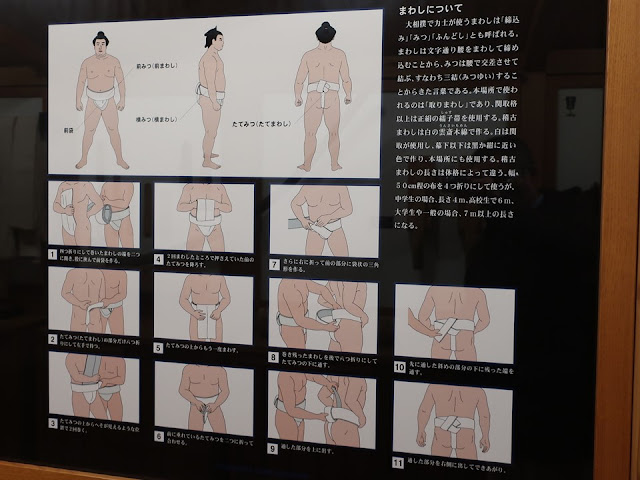Ajigasawa town in Aomori prefecture faces the
Sea of Japan. It is a fisherman’s town.
It is also the home town of Mainoumi who was
one of the most popular sumo wrestlers, because he was small for a wrestler but used
various techniques and beat bigger rivals.
Mainoumi’s very exciting matches <Must See>:
https://www.youtube.com/watch?v=JKWTIgWDJqg
This museum exhibits mainly about Mainoumi,
and exhibits many items about sumo which is longstanding fun to watch and to play.
I was surprised with the exhibit of
Mainoumi’s ichou-mage (part of hair). It is very rare.
鰺ヶ沢町は、弘前から日本海に向かう交通の要衝、津軽平野の入口、漁港の町です。
青森県は大勢の力士を生んでいます。この資料館、鰺ヶ沢出身の舞の海の紹介を中心にした資料館です。ですが、今の相撲のことは何でも分かる資料館です。相撲は見て良し取って良し、楽しみですね。
ビックリしたのは、舞の海の「まげ」の展示。まげは力士の命といいますが、展示されていました。
The interior is made of wood. The full-scale panels are set in the room. He is only 173cm tall.
木の内装です。舞の海は実物大の大きさ、入門時はシリコンを入れ身長は173cmでした。
There is the sumo ring (Dohyou) in the room. Exhibits about sumo and Ajigasawa surround this room.
土俵、その向こうで舞の海の激戦が上映されています。この部屋の周りに相撲の全てと鰺ヶ沢町が紹介されています。
“心”(Shin; mental strength),”技”(Gi; technical strength) and ”体”(Tai; physical strength) are three important things to train. The highest rank There are rules about colors and direction, because the sumo is the Shinto ritual. wrote this.
相撲といえば、「心技体」。33代庄之助(2006~2007)の書です。
His hair topknot, which was cut after retirement in 1999, is very impressive. His master cut it.
髷がスゴイな。1999年の引退後、師匠に切って頂いたものですね。
There are rules about colors and direction, because the sumo is the Shinto ritual.
相撲場の構造:方位や色が決められており、「神事、年占の場であった相撲の伝統を示すもの」と書かれていました。
Tools to make it、土俵を作る用具
Staff、興行を支える人達
Sumo referee’s outfit varies due to the rank.
行司。その装束の変遷のパネルもありました。
An usher’s outfit、呼び出しの衣装
The way to put on the loincloth “Mawashi”. You can try it.
まわしの締め方(体験コーナー)
Cotton loincloths are used while training. The high rank wrestlers “Sekitori” use silk ones at a tournament.
木綿の稽古まわし。本場所では、関取以上は正絹の「取りまわし」を使います。
The procedure of sumo match、相撲の作法
Sumo as a Shinto ritual、神事としての相撲
“Yumi-tori” is performed at the end of match day.
弓取り式。平安時代は一番ごとに舞ったそうです。神事ですね。
In some places, sumo is played on the straw ropes which are used in the tug of war rite. The tag rope imagines the dragon which is the water god.
相撲の民俗誌:相撲の語源スマイは、神を呼ぶ舞、という意味でした。これが、豊凶を占う年占(としうら)の競技になり、やがて、宮廷での相撲節会、近世の勧進相撲になりました。8/15に水神である龍をイメージさせる綱引きで豊凶を占う地域では、その綱で土俵を作り、相撲を取る習俗が多く見られるそうです。
The museum is on the second floor of the roadside station.
相撲館は、海の駅(道の駅)の二階にあります。
Reference: Ryogoku and Sumo Museum 両国と相撲博物館 (museum and the town where tournaments have been held since the Edo period)
Ajigasawa town、鰺ヶ沢の町
It was bleak when I visited. There is a fishing port in front of the roadside station, so we can buy fresh seafood there.
訪問時は荒涼としていましたが、目の前は漁港です。海の駅では新鮮な海の幸がたくさん売られています。
The town is a little rusty, honestly say. However, seafood is really good, I ate sashimi raw fish rice bowl. Flounder “Hirame”, which was soaked in soy source, were topped. Ajigasawa town recommends this. Delicious!
日本海に面する町自体は、正直、寂れた感じでしたが、海の幸が良い。町で推しているヒラメの漬け丼、とても美味しかったです。
I drove from Ajigasawa to Fukaura which is another port on the coast.
鰺ヶ沢からは、日本海沿い、五能線沿いに、深浦に向かいました。名所、千畳敷海岸です。
Visited in October, 2020
Official website: http://www.ajiiku.jp/en/ (this page
includes the museum)
http://www.ajiiku.jp/category/detail.html?cid=1&aid=00002046
(in Japanese), accessed in Jun, 2021
Previous post (One of the most famous ancient sites which is in Aomori):
Next post (Museum
in Fukaura):
Fukaura history and folklore museum、深浦町歴史民俗資料館


























Comments
Post a Comment